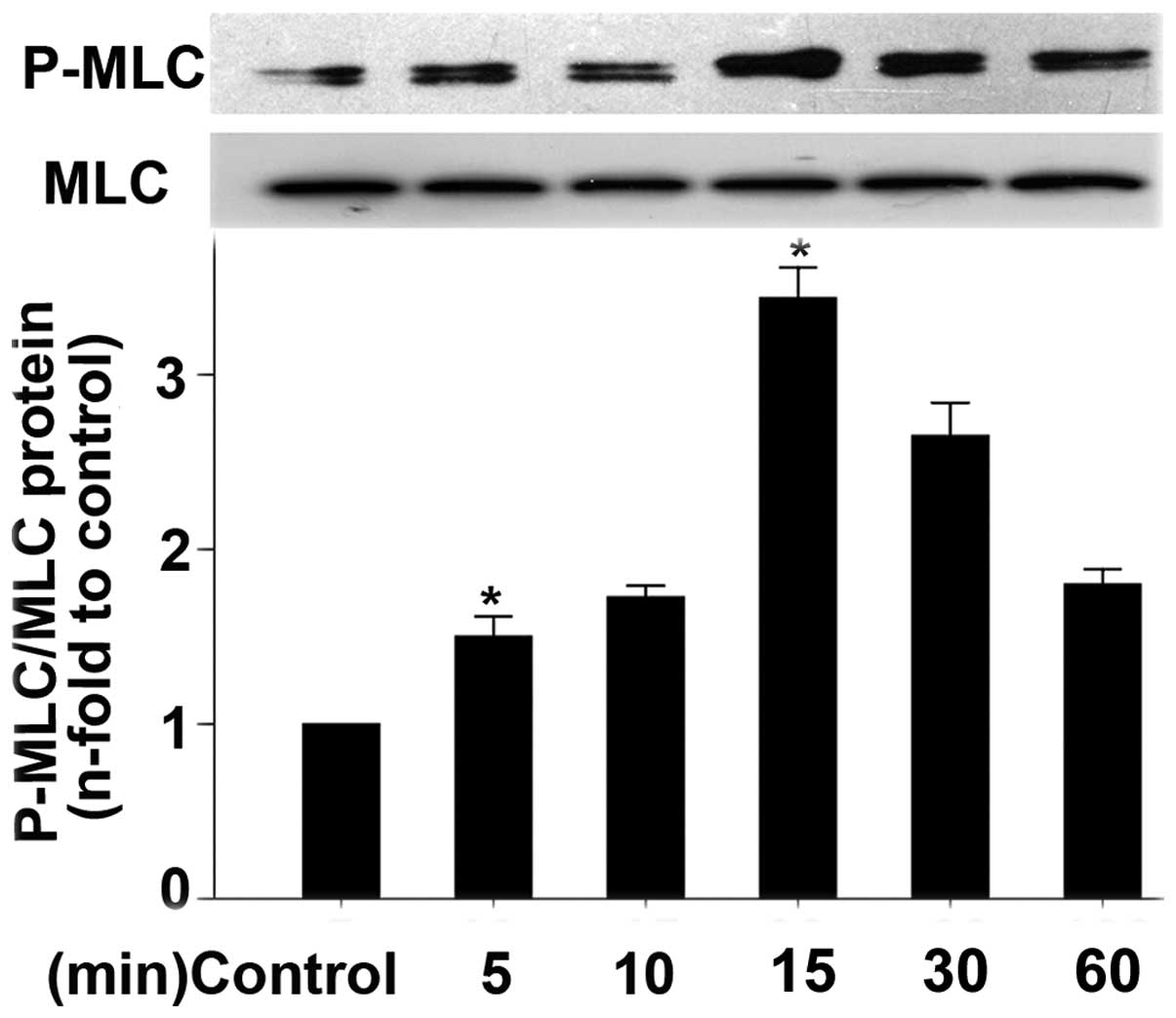|
1.
|
MI PhillipsEA SpeakmanB KimuraLevels of
angiotensin and molecular biology of the tissue renin angiotensin
systemsRegul Pept43120199310.1016/0167-0115(93)90403-U8426906
|
|
2.
|
RP MarshallP GohlkeRC ChambersDC HowellSE
BottomsT UngerRJ McAnultyGJ LaurentAngiotensin II and the
fibroproliferative response to acute lung injuryAm J Physiol Lung
Cell Mol
Physiol286L156L164200410.1152/ajplung.00313.200212754187
|
|
3.
|
E CojocaruIL DumitriuG BogdanM
CostuleanuSM SlatineanuG PetrescuInvolvement of angiotensin on
adenosine-induced bronchial hyperreactivityPneumologia5819232009(In
Romanian)
|
|
4.
|
A VeerappanAC ReidR EstephanN O’ConnorM
Thadani-MuleroM Salazar-RodriguezR LeviRB SilverMast cell renin and
a local renin-angiotensin system in the airway: role in
bronchoconstrictionProc Natl Acad Sci
USA10513151320200810.1073/pnas.070973910518202178
|
|
5.
|
J ZhongR BasuD GuoFL ChowS ByrnsM
SchusterH LoibnerXH WangJM PenningerZ KassiriGY
OuditAngiotensin-converting enzyme 2 suppresses pathological
hypertrophy, myocardial fibrosis and cardiac
dysfunctionCirculation122717728201010.1161/CIRCULATIONAHA.110.95536920679547
|
|
6.
|
M IwaiM HoriuchiDevil and angel in the
renin-angiotensin system: ACE-angiotensin II-AT1 receptor axis vs.
ACE2-angiotensin-(1-7)-Mas receptor axisHypertens
Res32533536200910.1038/hr.2009.7419461648
|
|
7.
|
JL GrobeAP MeccaM LingisV ShenoyTA
BoltonJM MachadoRC SpethMK RaizadaMJ KatovichPrevention of
angiotensin II-induced cardiac remodeling by angiotensin-(1-7)Am J
Physiol Heart Circ
Physiol292H736H742200710.1152/ajpheart.00937.200617098828
|
|
8.
|
V EstebanS Heringer-WaltherA Sterner-KockR
de BruinS van den EngelY WangS MezzanoJ EgidoHP SchultheissM
Ruiz-OrtegaT Waltherangiotensin-(1-7) and the g protein-coupled
receptor MAS are key players in renal inflammationPLoS
One4e5406200910.1371/journal.pone.000540619404405
|
|
9.
|
RA SantosAC Simoes e SilvaC MaricDM
SilvaRP MachadoI de BuhrS Heringer-WaltherSV PinheiroMT LopesM
Baderangiotensin-(1-7) is an endogenous ligand for the G
protein-coupled receptor MasProc Natl Acad Sci
USA10082588263200310.1073/pnas.143286910012829792
|
|
10.
|
W LiMJ MooreN VasilievaJ SuiSK WongMA
BerneM SomasundaranJL SullivanK LuzuriagaTC
GreenoughAngiotensin-converting enzyme 2 is a functional receptor
for the SARS
coronavirusNature426450454200310.1038/nature0214514647384
|
|
11.
|
I HammingW TimensML BulthuisAT LelyGJ
NavisH van GoorTissue distribution of ACE2 protein, the functional
receptor for SARS coronavirus. A first step in understanding SARS
pathogenesisJ Pathol203631637200410.1002/path.157015141377
|
|
12.
|
T WangKS YinKY LiuGJ LuYH LiJD ChenEffect
of valsartan on the expression of angiotensin II receptors in the
lung of chronic antigen exposure ratsChin Med J
(Engl)12123122319200819080339
|
|
13.
|
N KogataRM TribeR FasslerM WayRH
AdamsIntegrin-linked kinase controls vascular wall formation by
negatively regulating Rho/ROCK-mediated vascular smooth muscle cell
contractionGenes Dev2322782283200910.1101/gad.53540919797768
|
|
14.
|
Y WangXR ZhengN RiddickM BrydenW BaurX
ZhangHK SurksROCK isoform regulation of myosin phosphatase and
contractility in vascular smooth muscle cellsCirc
Res104531540200910.1161/CIRCRESAHA.108.18852419131646
|
|
15.
|
K KimuraS EguchiAngiotensin II type-1
receptor regulates RhoA and Rho-kinase/ROCK activation via multiple
mechanisms. Focus on ‘Angiotensin II induces RhoA activation
through SHP2-dependent dephosphorylation of the RhoGAP p190A in
vascular smooth muscle cells’Am J Physiol Cell
Physiol297C1059C1061200919741194
|
|
16.
|
H OhtsuM MifuneGD FrankS SaitoT InagamiS
Kim-MitsuyamaY TakuwaT SasakiJD RothsteinH SuzukiSignal-crosstalk
between Rho/ROCK and c-Jun NH2-terminal kinase mediates migration
of vascular smooth muscle cells stimulated by angiotensin
IIArterioscler Thromb Vasc
Biol2518311836200510.1161/01.ATV.0000175749.41799.9b15994438
|
|
17.
|
J LiR KurubaA WilsonX GaoY ZhangS
LiInhibition of endothelin-1-mediated contraction of hepatic
stellate cells by FXR ligandPLoS
One5e13955201010.1371/journal.pone.001395521085652
|
|
18.
|
R GosensD SchaafsmaH MeursJ ZaagsmaSA
NelemansRole of Rho-kinase in maintaining airway smooth muscle
contractile phenotypeEur J
Pharmacol4837178200410.1016/j.ejphar.2003.10.02714709328
|
|
19.
|
PV LoGrassoY FengRho kinase (ROCK)
inhibitors and their application to inflammatory disordersCurr Top
Med Chem9704723200910.2174/15680260978904445219689376
|
|
20.
|
V Regitz-ZagrosekM NeussJ HolzmeisterC
WarneckeE FleckMolecular biology of angiotensin receptors and their
role in human cardiovascular diseaseJ Mol
Med74233251199610.1007/BF001965778773261
|
|
21.
|
A BretscherK EdwardsRG FehonERM proteins
and merlin: integrators at the cell cortexNat Rev Mol Cell
Biol3586599200210.1038/nrm88212154370
|
|
22.
|
RM TouyzG YaoE VielF AmiriEL
SchiffrinAngiotensin II and endothelin-1 regulate MAP kinases
through different redox-dependent mechanisms in human vascular
smooth muscle cellsJ
Hypertens2211411149200410.1097/00004872-200406000-0001515167449
|
|
23.
|
EA MillarJE NallyNC ThomsonAngiotensin II
potentiates methacholine-induced bronchoconstriction in human
airway both in vitro and in vivoEur Respir
J818381841199510.1183/09031936.95.081118388620948
|
|
24.
|
YG ZhangXB LiJ ZhangJ HuangC HeC TianY
DengH WanD ShresthaYY YangH FanThe I/D polymorphism of
angiotensin-converting enzyme gene and asthma risk: a
meta-analysisAllergy66197205201110.1111/j.1398-9995.2010.02438.x20880211
|
|
25.
|
N KitamuraO KaminumaN KobayashiA MoriA
contraction assay system using established human bronchial smooth
muscle cellsInt Arch Allergy Immunol146Suppl
1S36S39200810.1159/00012605918504405
|
|
26.
|
N KitamuraO KaminumaT OhtomoN KiyokawaN
KobayashiM SukoA MoriEvaluation of cysteinyl leukotriene-induced
contraction of human cultured bronchial smooth muscle cellsInt Arch
Allergy Immunol149Suppl 18386200910.1159/00021137819494511
|
|
27.
|
H MatsumotoLM MoirBG OliverJK BurgessM
RothJL BlackBE McParlandComparison of gel contraction mediated by
airway smooth muscle cells from patients with and without
asthmaThorax62848854200710.1136/thx.2006.07047417412779
|
|
28.
|
JF GianiMM GironacciMC MunozC PenaD
TurynFP DominiciAngiotensin-(1 7) stimulates the phosphorylation of
JAK2, IRS-1 and Akt in rat heart in vivo: role of the AT1 and Mas
receptorsAm J Physiol Heart Circ
Physiol293H1154H1163200710.1152/ajpheart.01395.200617496209
|
|
29.
|
Z SuJ ZimpelmannKD Burnsangiotensin-(1-7)
inhibits angiotensin II-stimulated phosphorylation of MAP kinases
in proximal tubular cellsKidney
Int6922122218200610.1038/sj.ki.500150916672906
|
|
30.
|
N HayashiK YamamotoM OhishiY TataraY
TakeyaA ShiotaR OguroY IwamotoM TakedaH RakugiThe counterregulating
role of ACE2 and ACE2-mediated angiotensin 1–7 signaling against
angiotensin II stimulation in vascular cellsHypertens
Res3311821185201020703229
|
|
31.
|
JP CollisterMD HendelThe role of Ang (1-7)
in mediating the chronic hypotensive effects of losartan in normal
ratsJ Renin Angiotensin Aldosterone
Syst4176179200310.3317/jraas.2003.02814608523
|
|
32.
|
RM LeeM BaderN AleninaRA SantosYJ GaoC
LuMas receptors in modulating relaxation induced by perivascular
adipose tissueLife
Sci89467472201110.1016/j.lfs.2011.07.01621820449
|
|
33.
|
BD UhalX LiA XueX GaoA
Abdul-HafezRegulation of alveolar epithelial cell survival by the
ACE-2/angiotensin 1–7/Mas axisAm J Physiol Lung Cell Mol
Physiol301L269L274201121665960
|
|
34.
|
C Cario-ToumaniantzD Ferland-McColloughG
ChadeufG ToumaniantzM RodriguezJP GalizziB LockhartA BrilE
ScalbertG LoirandP PacaudRhoA guanine exchange factor expression
profile in arteries: Evidence for a Rho kinase-dependent negative
feedback in angiotensin II-dependent hypertensionAm J Physiol Cell
Physiol302C1394C1404201210.1152/ajpcell.00423.2011
|
|
35.
|
C SavoiaF TabetG YaoEL SchiffrinRM
TouyzNegative regulation of RhoA/Rho kinase by angiotensin II type
2 receptor in vascular smooth muscle cells: role in angiotensin
II-induced vasodilation in stroke-prone spontaneously hypertensive
ratsJ Hypertens2310371045200510.1097/01.hjh.0000166845.49850.39
|
|
36.
|
CD GildnerAL LernerDC HockingFibronectin
matrix polymerization increases tensile strength of model tissueAm
J Physiol Heart Circ
Physiol287H46H53200410.1152/ajpheart.00859.200315001442
|
|
37.
|
DC HockingJ SottileKJ
LangenbachStimulation of integrin-mediated cell contractility by
fibronectin polymerizationJ Biol
Chem2751067310682200010.1074/jbc.275.14.1067310744764
|

















